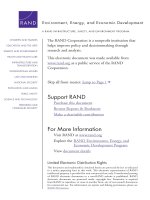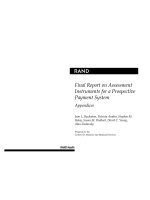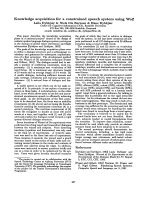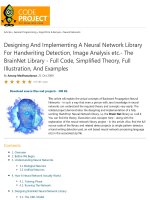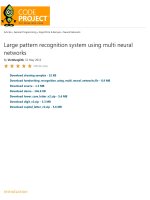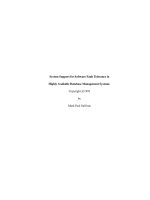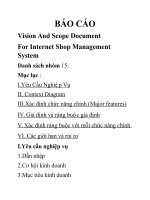library for online handwriting recognition system using unipen database
Bạn đang xem bản rút gọn của tài liệu. Xem và tải ngay bản đầy đủ của tài liệu tại đây (1.11 MB, 15 trang )
Articles » General Programming » Algorithms & Recipes » Neural Networks
Library for online handwriting recognition system using
UNIPEN database.
By Vietdungiitb, 2 May 2012
Download capital_letters__digit_89_.zip - 5.6 MB
Download lowcase_letter_89_.zip - 5.6 MB
Download numberic_97_.zip - 2.3 MB
Download source - 1 MB
Download demo - 114.9 KB
Introduction
This project has been started from my desire to create a small program on a surface computer (window 8 or Android
tablet) which can recognize what my 5 years old daughter draws on it and helps her to study numbers and alphabet
characters. I know it is very hard work relating to machine learning and pattern recognition. The program may not be
completed until my daughter finishes her secondary school program but it is good reason to me to spend my free
time on it. At the present, the project has achieved several good results such as: a library for manipulating UNIPEN
database, a library for creating a neural network dynamically on runtime and some classes for character segmentation
etc. These archives have encouraged me to continue to develope the project as well as to share it to community in
order to help juniors easier to study pattern recognition techniques in general and online handwriting recognition
techniques in particular.
4.90 (24 votes)
The demo can recognize not only digit but also letters on mouse drawing control by using multi neural network at the
same time.
co
Picture 1a: Isolated character segmentation
Picture1b: convolution network for capital letters and digits recognition
Background
This library is divided to three parts:
Part 1: UNIPEN – online handwriting training database library: it has several classes manipulating UNIPEN
database, one of the most popular handwriting database over the world.
Part 2: Convolution neural network library: the library is organized based on neural network’s objects including:
network, layer, neuron, weight, connection, activation function, forward propagation, back propagation classes. It is
simple to a junior to create not only a traditional neural network but also a convolution network with smallest effort.
Especially, the library also supports creating a network on runtime. So we can create or change different networks
when the program is running.
Part 3: Image segmentation library: it is some functions for image pre-processing and segmentation. It is in
developing process.
Picture 2: Character segmentation
These techniques have been introduced in previous topics “UPV – UNIPEN online handwriting recognition
database viewer control ” and ”Neural Network for Recognition of Handwritten Digits in C#”. However, this
article is a synthesis of them which can bring a more general view to a handwriting recognition system. In this article I
will highlight a method is used to get the UNIPEN data to the input of a recognizer. A convolution network for capital
letters and numbers recognition also is described in order to explain how to use this library.
The UNIPEN and its format
Picture 2: UNIPEN data browser with function for capital letters and digits recognition.
In a large collaborative effort, a wide number of research institutes and industry have generated the UNIPEN standard
and database. Originally hosted by NIST, the data was divided into two distributions, dubbed the trainset and devset.
Since 1999, the International UNIPEN Foundation (iUF) hosts the data, with the goal to safeguard the distribution of
the trainset and to promote the use of online handwriting in research and applications. In the last years, dozens of
researchers have used the trainset and described experimental performance results. Many researchers have reported
well established research with proper recognition rates, but all applied some particular configuration of the data. In
most cases the data were decomposed, using some specific procedure, into three subsets for training, testing and
validation. Therefore, although the same source of data was used, recognition results cannot really be compared as
different decomposition techniques were employed.
For some time now, it has been the goal of the iUF to organize a benchmark on the remaining data set, the devset.
Although the devset is available to some of the original contributors to UNIPEN, it has not officially been released to a
broad audience yet. I have been no luck to work on it.
Due to UNIPEN trainset is collection of particular datasets from different research institutes, these datasets are
decomposed using some specific procedure. However, my approach is a little bit different; I tried to find some general
points in the structure of these datasets to create a procedure which can decompose all datasets in the trainset
correctly in most cases.
The trainset is organized as follows:
cat nsegm nfiles
1a 15953 634 isolated digits
1b 28069 1423 isolated upper case
1c 61351 2145 isolated lower case
1d 17286 1222 isolated symbols (punctuations etc.)
2 122628 2735 isolated characters, mixed case
3 67352 1949 isolated characters in the context of words or texts
4 0 0 isolated printed words, not mixed with digits and symbols
5 0 0 isolated printed words, full character set
6 75529 3298 isolated cursive or mixed-style words (without digits and symbols)
7 85213 3393 isolated words, any style, full character set
8 14544 4563 text: (minimally two words of) free text, full character set
The UNIPEN format is described in here. The format is thought of as a sequence of pen coordinates, annotated with
various information, including segmentation and labeling. The pen trajectory is encoded as a sequence of components
.PEN DOWN and .PEN UP, containing pen coordinates (e.g. XY or XY T as declared in .COORD). The instruction .DT
permits précising the elapsed time between two components. The database is divided into one or several data sets
starting with .START SET. Within a set, components are implicitly numbered, starting from zero. Segmentation and
labeling are provided by the .SEGMENT instruction. Component numbers are used by .SEGMENT to delineate
sentences, words, characters. A segmentation hierarchy (e.g. SENTENCE WORD CHARACTER) is declared with
.HIERARCHY . Because components are referred by a unique combination of set name and order number in that set, it
is possible to separate the .SEGMENT from the data itself.
In general, the format of a UNIPEN data file has KEYWORDS which are divided to several groups like: Mandatory
declarations, Data documentation, Alphabet, Lexicon, Data layout, Unit system, Pen trajectory¸ Data annotations. In
order to get the information and categorize these keywords, I built a collection of classes based on the above groups
which can help me to get and categorize all necessary information from data file.
Although the UNIPEN format based on KEYWORD but it not fix in a specific order. I created a DataSet class like a
storage racks, when a KEYWORD is found it will be categorized and put to a correspondent rack. In the normal, each
UNIPEN file contains one or several Datasets. But, in most cases there is a DataSet in a file. My library now focuses on
this case only.
Getting training patterns (Pen trajectory bitmaps) from trainset using the library is very simple as follows:
private void btnOpen_Click(object sender, EventArgs e)
{
if (dataProvider.IsDataStop == true)
{
try
{
FolderBrowserDialog fbd = new FolderBrowserDialog();
// Show the FolderBrowserDialog.
DialogResult result = fbd.ShowDialog();
if (result == DialogResult.OK)
{
bool fn = false;
string folderName = fbd.SelectedPath;
Task[] tasks = new Task[2];
isCancel = false;
tasks[0] = Task.Factory.StartNew(() =>
{
dataProvider.IsDataStop = false;
this.Invoke(DelegateAddObject, new object[] { 0, "Getting image training
data, please be patient " });
dataProvider.GetPatternsFromFiles(folderName); //get patterns with
default parameters
dataProvider.IsDataStop = true;
if (!isCancel)
{
this.Invoke(DelegateAddObject, new object[] { 1, "Congatulation!
Image training data loaded succesfully!" });
dataProvider.Folder.Dispose();
isDatabaseReady = true;
}
else
{
this.Invoke(DelegateAddObject, new object[] { 98, "Sorry! Image
training data loaded fail!" });
}
fn = true;
});
tasks[1] = Task.Factory.StartNew(() =>
{
int i = 0;
while (!fn)
{
Thread.Sleep(100);
this.Invoke(DelegateAddObject, new object[] { 99, i });
i++;
if (i >= 100)
i = 0;
}
});
}
}
catch (Exception ex)
{
MessageBox.Show(ex.ToString());
}
}
else
{
DialogResult result = MessageBox.Show("Do you really want to cancel this process?",
"Cancel loadding Images", MessageBoxButtons.YesNo);
if (result == DialogResult.Yes)
{
dataProvider.IsDataStop = true;
isCancel = true;
}
}
}
After that, the patterns will be the training data to a neural network:
private void btTrain_Click(object sender, EventArgs e)
{
if (isDatabaseReady && !isTrainingRuning)
{
TrainingParametersForm form = new TrainingParametersForm();
form.Parameters = nnParameters;
DialogResult result = form.ShowDialog();
if (result == DialogResult.OK)
{
nnParameters = form.Parameters;
ByteImageData[] dt = new ByteImageData[dataProvider.ByteImagePatterns.Count];
dataProvider.ByteImagePatterns.CopyTo(dt);
nnParameters.RealPatternSize = dataProvider.PatternSize;
if (network == null)
{
CreateNetwork(); //create network for training
NetworkInformation();
}
var ntraining = new Neurons.NNTrainPatterns(network, dt, nnParameters, true,
this);
tokenSource = new CancellationTokenSource();
token = tokenSource.Token;
this.btTrain.Image = global::NNControl.Properties.Resources.Stop_sign;
this.btLoad.Enabled = false;
this.btnOpen.Enabled = false;
maintask = Task.Factory.StartNew(() =>
{
if (stopwatch.IsRunning)
{
// Stop the timer; show the start and reset buttons.
stopwatch.Stop();
}
else
{
// Start the timer; show the stop and lap buttons.
stopwatch.Reset();
stopwatch.Start();
}
isTrainingRuning = true;
ntraining.BackpropagationThread(token);
if (token.IsCancellationRequested)
{
String s = String.Format("BackPropagation is canceled");
this.Invoke(this.DelegateAddObject, new Object[] { 4, s });
token.ThrowIfCancellationRequested();
}
},token);
}
}
else
{
tokenSource.Cancel();
}
}
Convolution neural network
Theory of convolution network has been described in my previous article and several others on Codeproject. In this
article, I will only focus on what development in this library compares to the previous program.
This library has been re-written completely to fit my current requirement: easy to use to juniors who do not need a
deep knowledge on neural network; creating a neural network simply, changing network parameters without changing
code and especially is the capacity of exchanging different networks on runtime.
CreateNetwork function in previous program:
private bool CreateNNNetWork(NeuralNetwork network)
{
NNLayer pLayer;
int ii, jj, kk;
int icNeurons = 0;
int icWeights = 0;
double initWeight;
String sLabel;
var m_rdm = new Random();
// layer zero, the input layer.
// Create neurons: exactly the same number of neurons as the input
// vector of 29x29=841 pixels, and no weights/connections
pLayer = new NNLayer("Layer00", null);
network.m_Layers.Add(pLayer);
for (ii = 0; ii < 841; ii++)
{
sLabel = String.Format("Layer00_Neuro{0}_Num{1}", ii, icNeurons);
pLayer.m_Neurons.Add(new NNNeuron(sLabel));
icNeurons++;
}
//double UNIFORM_PLUS_MINUS_ONE= (double)(2.0 * m_rdm.Next())/Constants.RAND_MAX - 1.0 ;
// layer one:
// This layer is a convolutional layer that has 6 feature maps. Each feature
// map is 13x13, and each unit in the feature maps is a 5x5 convolutional kernel
// of the input layer.
// So, there are 13x13x6 = 1014 neurons, (5x5+1)x6 = 156 weights
pLayer = new NNLayer("Layer01", pLayer);
network.m_Layers.Add(pLayer);
for (ii = 0; ii < 1014; ii++)
{
sLabel = String.Format("Layer01_Neuron{0}_Num{1}", ii, icNeurons);
pLayer.m_Neurons.Add(new NNNeuron(sLabel));
icNeurons++;
}
for (ii = 0; ii < 156; ii++)
{
sLabel = String.Format("Layer01_Weigh{0}_Num{1}", ii, icWeights);
initWeight = 0.05 * (2.0 * m_rdm.NextDouble() - 1.0);
pLayer.m_Weights.Add(new NNWeight(sLabel, initWeight));
}
// interconnections with previous layer: this is difficult
// The previous layer is a top-down bitmap image that has been padded to size 29x29
// Each neuron in this layer is connected to a 5x5 kernel in its feature map, which
// is also a top-down bitmap of size 13x13. We move the kernel by TWO pixels, i.e., we
// skip every other pixel in the input image
int[] kernelTemplate = new int[25] {
29, 30, 31, 32, 33,
58, 59, 60, 61, 62,
87, 88, 89, 90, 91,
116,117,118,119,120 };
0, 1, 2, 3, 4,
int iNumWeight;
int fm;
for (fm = 0; fm < 6; fm++)
{
for (ii = 0; ii < 13; ii++)
{
for (jj = 0; jj < 13; jj++)
{
iNumWeight = fm * 26; // 26 is the number of weights per feature map
NNNeuron n = pLayer.m_Neurons[jj + ii * 13 + fm * 169];
n.AddConnection((uint)MyDefinations.ULONG_MAX, (uint)iNumWeight++); // bias
weight
for (kk = 0; kk < 25; kk++)
{
// note: max val of index == 840, corresponding to 841 neurons in prev
layer
n.AddConnection((uint)(2 * jj + 58 * ii + kernelTemplate[kk]),
(uint)iNumWeight++);
}
}
}
}
// layer two:
// This layer is a convolutional layer that has 50 feature maps. Each feature
// map is 5x5, and each unit in the feature maps is a 5x5 convolutional kernel
// of corresponding areas of all 6 of the previous layers, each of which is a 13x13
feature map
// So, there are 5x5x50 = 1250 neurons, (5x5+1)x6x50 = 7800 weights
pLayer = new NNLayer("Layer02", pLayer);
network.m_Layers.Add(pLayer);
for (ii = 0; ii < 1250; ii++)
{
sLabel = String.Format("Layer02_Neuron{0}_Num{1}", ii, icNeurons);
pLayer.m_Neurons.Add(new NNNeuron(sLabel));
icNeurons++;
}
for (ii = 0; ii < 7800; ii++)
{
sLabel = String.Format("Layer02_Weight{0}_Num{1}", ii, icWeights);
initWeight = 0.05 * (2.0 * m_rdm.NextDouble() - 1.0);
pLayer.m_Weights.Add(new NNWeight(sLabel, initWeight));
}
// Interconnections with previous layer: this is difficult
// Each feature map in the previous layer is a top-down bitmap image whose size
// is 13x13, and there are 6 such feature maps. Each neuron in one 5x5 feature map of
this
// layer is connected to a 5x5 kernel positioned correspondingly in all 6 parent
// feature maps, and there are individual weights for the six different 5x5 kernels. As
// before, we move the kernel by TWO pixels, i.e., we
// skip every other pixel in the input image. The result is 50 different 5x5 top-down
bitmap
// feature maps
int[] kernelTemplate2 = new int[25]{
0, 1, 2, 3, 4,
13, 14, 15, 16, 17,
26, 27, 28, 29, 30,
39, 40, 41, 42, 43,
52, 53, 54, 55, 56 };
for (fm = 0; fm < 50; fm++)
{
for (ii = 0; ii < 5; ii++)
{
for (jj = 0; jj < 5; jj++)
{
iNumWeight = fm * 156; // 26 is the number of weights per feature map
NNNeuron n = pLayer.m_Neurons[jj + ii * 5 + fm * 25];
n.AddConnection((uint)MyDefinations.ULONG_MAX, (uint)iNumWeight++); // bias
weight
for (kk = 0; kk < 25; kk++)
{
// note: max val of index == 1013, corresponding to 1014 neurons in prev
layer
n.AddConnection((uint)(2 * jj + 26 * ii + kernelTemplate2[kk]),
(uint)iNumWeight++);
n.AddConnection((uint)(169 + 2 * jj + 26 * ii + kernelTemplate2[kk]),
(uint)iNumWeight++);
n.AddConnection((uint)(338 + 2 * jj + 26 * ii + kernelTemplate2[kk]),
(uint)iNumWeight++);
n.AddConnection((uint)(507 + 2 * jj + 26 * ii + kernelTemplate2[kk]),
(uint)iNumWeight++);
n.AddConnection((uint)(676 + 2 * jj + 26 * ii + kernelTemplate2[kk]),
(uint)iNumWeight++);
n.AddConnection((uint)(845 + 2 * jj + 26 * ii + kernelTemplate2[kk]),
(uint)iNumWeight++);
}
}
}
}
// layer three:
// This layer is a fully-connected layer with 100 units. Since it is fully-connected,
// each of the 100 neurons in the layer is connected to all 1250 neurons in
// the previous layer.
// So, there are 100 neurons and 100*(1250+1)=125100 weights
pLayer = new NNLayer("Layer03", pLayer);
network.m_Layers.Add(pLayer);
for (ii = 0; ii < 100; ii++)
{
sLabel = String.Format("Layer03_Neuron{0}_Num{1}", ii, icNeurons);
pLayer.m_Neurons.Add(new NNNeuron(sLabel));
icNeurons++;
}
for (ii = 0; ii < 125100; ii++)
{
sLabel = String.Format("Layer03_Weight{0}_Num{1}", ii, icWeights);
initWeight = 0.05 * (2.0 * m_rdm.NextDouble() - 1.0);
pLayer.m_Weights.Add(new NNWeight(sLabel, initWeight));
}
// Interconnections with previous layer: fully-connected
iNumWeight = 0; // weights are not shared in this layer
for (fm = 0; fm < 100; fm++)
{
NNNeuron n = pLayer.m_Neurons[fm];
n.AddConnection((uint)MyDefinations.ULONG_MAX, (uint)iNumWeight++); // bias weight
for (ii = 0; ii < 1250; ii++)
{
n.AddConnection((uint)ii, (uint)iNumWeight++);
}
}
// layer four, the final (output) layer:
// This layer is a fully-connected layer with 10 units. Since it is fully-connected,
// each of the 10 neurons in the layer is connected to all 100 neurons in
// the previous layer.
// So, there are 10 neurons and 10*(100+1)=1010 weights
pLayer = new NNLayer("Layer04", pLayer);
network.m_Layers.Add(pLayer);
for (ii = 0; ii < 10; ii++)
{
sLabel = String.Format("Layer04_Neuron{0}_Num{1}", ii, icNeurons);
pLayer.m_Neurons.Add(new NNNeuron(sLabel));
icNeurons++;
}
for (ii = 0; ii < 1010; ii++)
{
sLabel = String.Format("Layer04_Weight{0}_Num{1}", ii, icWeights);
initWeight = 0.05 * (2.0 * m_rdm.NextDouble() - 1.0);
pLayer.m_Weights.Add(new NNWeight(sLabel, initWeight));
}
// Interconnections with previous layer: fully-connected
iNumWeight = 0; // weights are not shared in this layer
for (fm = 0; fm < 10; fm++)
{
var n = pLayer.m_Neurons[fm];
n.AddConnection((uint)MyDefinations.ULONG_MAX, (uint)iNumWeight++); // bias weight
for (ii = 0; ii < 100; ii++)
{
n.AddConnection((uint)ii, (uint)iNumWeight++);
}
}
return true;
}
CreateNetwork function in current demo using this library:
private List<Char> Letters2 = new List<Char>(36) { 'A', 'B', 'C', 'D', 'E', 'F', 'G', 'H',
'I', 'J', 'K', 'L', 'M', 'N', 'O', 'P', 'Q', 'R', 'S', 'T', 'U', 'V', 'W', 'X', 'Y', 'Z',
'0', '1', '2', '3', '4', '5', '6', '7', '8', '9' };
private List<Char> Letters = new List<Char>(62) { 'A', 'B', 'C', 'D', 'E', 'F', 'G', 'H',
'I', 'J', 'K', 'L', 'M', 'N', 'O', 'P', 'Q', 'R', 'S', 'T', 'U', 'V', 'W', 'X', 'Y', 'Z',
'a', 'b', 'c', 'd', 'e', 'f', 'g', 'h', 'i', 'j', 'k', 'l', 'm', 'n', 'o', 'p', 'q', 'r',
's', 't', 'u', 'v', 'w', 'x', 'y', 'z', '0', '1', '2', '3', '4', '5', '6', '7', '8', '9' };
private List<Char> Letters1 = new List<Char>(10) { '0', '1', '2', '3', '4', '5', '6', '7',
'8', '9' };
void CreateNetwork1()
{
network = new ConvolutionNetwork();
//layer 0: inputlayer
network.Layers = new NNLayer[5];
network.LayerCount = 5;
NNLayer layer = new NNLayer("00-Layer Input", null, new Size(29, 29), 1, 5);
network.InputDesignedPatternSize = new Size(29, 29);
layer.Initialize();
network.Layers[0] = layer;
layer = new NNLayer("01-Layer ConvolutionalSubsampling", layer, new Size(13, 13), 6, 5);
layer.Initialize();
network.Layers[1] = layer;
layer = new NNLayer("02-Layer ConvolutionalSubsampling", layer, new Size(5, 5), 50, 5);
layer.Initialize();
network.Layers[2] = layer;
layer = new NNLayer("03-Layer FullConnected", layer, new Size(1, 100), 1, 5);
layer.Initialize();
network.Layers[3] = layer;
layer = new NNLayer("04-Layer FullConnected", layer, new Size(1, Letters1.Count), 1, 5);
layer.Initialize();
network.Layers[4] = layer;
network.TagetOutputs = Letters1;
}
In the current version, if I want to create a network which can recognize not only 10 digits but also alphabets (62
outputs total). I simply add some other layers and change some parameters as follows:
void CreateNetwork()
<pre> {
network = new ConvolutionNetwork();
//layer 0: inputlayer
network.Layers = new NNLayer[6];
network.LayerCount = 6;
NNLayer layer = new NNLayer("00-Layer Input", null, new Size(29, 29), 1, 5);
network.InputDesignedPatternSize = new Size(29, 29);
layer.Initialize();
network.Layers[0] = layer;
layer = new NNLayer("01-Layer ConvolutionalSubsampling", layer, new Size(13, 13), 10, 5);
layer.Initialize();
network.Layers[1] = layer;
layer = new NNLayer("02-Layer ConvolutionalSubsampling", layer, new Size(5, 5), 60, 5);
layer.Initialize();
network.Layers[2] = layer;
layer = new NNLayer("03-Layer FullConnected", layer, new Size(1, 300), 1, 5);
layer.Initialize();
network.Layers[3] = layer;
layer = new NNLayer("04-Layer FullConnected", layer, new Size(1, 200), 1, 5);
layer.Initialize();
network.Layers[4] = layer;
layer = new NNLayer("05-Layer FullConnected", layer, new Size(1, Letters.Count), 1, 5);
layer.Initialize();
network.Layers[5] = layer;
network.TagetOutputs = Letters;
}
We can change all network parameters such as: number of layers, input pattern size, number of feature map, kernel
size in convolution network, number of neuron in a layer, number of output etc. to have the best network for us.
Changing network is not influent to forward propagation or back propagation classes.
Experiment with the library:
The demo program presents two main functions of the library: UNIPEN data browser and Convolution neural network
training and testing. Of course the in put data is UNIPEN trainset which can be downloaded on the
website: In order to the demo program can run correctly, the trainset folder have to be
renamed to UnipenData.
Picture 4: UNIPEN data browser
We can simply select Data folder in UnipenData to browse all data. The recognition function can be active by loading a
network parameters file. Depend on the network file the program can recognize digits only or all capital letters plus
digits.
Picture 5: Convolution network training
The default convolution network is 62 outputs network. You can change the network by loading the attached
network parameters files. In order to get corrected training data, for example to a 36 outputs network (a network for
capital letters and digits) you should delete all folders in the Data folder except 1a,1b (a folder of digit and capital
letters).
In my experiment, results are rather good with 88% accuracy to the collection of capital letter and digits or 97% to
digits. I can not to do the experiment to 62 outputs network because my laptop was nearly burn when I trained the
network.
Points of Interest
As a human brain, an artificial intelligent system can not create a unique neural network with billions neurons inside to
solve different problems. It will contains several small networks which can solve seperated problems. My library has
this capacity. So I do hope that it can be applied not only to my daughter's program but also to a real system in some
day.
At the moment, this project is sponsored by my university as an annual small research. I am finding a donation or
scholarship to continue it. It will be highly appreciated if someone interested in this project and can help it more
developed.
The vote and comment to my article is welcome
History
Library version: 1.0 initial code
Version 1.01: fix bugs (Unipen library can read NicIcon, UJI-Penchar files correctly), add character segmentation
functions to Unipen library, fix bugs in neuron library. Previous network parameters are not compatible to current
version. If anybody downloaded version 1.0 demo, please download all file again.
Version 2.0 which can recognize 62 characters on a mouse drawing control (picture 1) will be posted on comming
article "Large pattern recognition system using multi neural networks"
License
Permalink | Advertise | Privacy | Mobile
Web02 | 2.6.121031.1 | Last Updated 3 May 2012
Article Copyright 2012 by Vietdungiitb
Everything else Copyright © CodeProject, 1999-2012
Terms of Use
This article, along with any associated source code and files, is licensed under The Code Project Open License (CPOL)
About the Author
Vietdungiitb
Vietnam Maritime University
Vietnam
Member
No Biography provided
Comments and Discussions
20 messages have been posted for this article Visit />online-handwriting-recognition-system to post and view comments on this article, or click here to get a print view
with messages.
